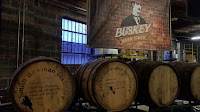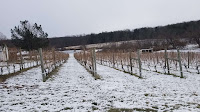 Great Oak Brewing - Southern Craft BBQ (Bristol, Virginia)
Great Oak Brewing - Southern Craft BBQ (Bristol, Virginia)Apparently, we missed a great spot during last year's Bristol Rhythm & Roots as Great Oak Brewery and Southern Craft BBQ opened at the tail end of State Street. The BBQ was excellent - try the burnt ends tacos or half chicken. The two beers I tried were as good. The Tennessee Uncommon Ale has a mash bill that includes corn and was more flavorful than expected. The Twin Eddies Coffee Porter was a surprisingly good pairing with the burnt ends. Can't wait to return for the 2022 music festival.
 Balter Beerworks (Knoxville, Tennessee)
Balter Beerworks (Knoxville, Tennessee)Another brewery with a tremendous kitchen (blackened Mahi wrap), Balter is located in downtown Knoxville and provides a full bar in addition to a dozen craft beers. I went with a flight that included the Good Neighbor Kolsch, Maypop American Pale Ale, Firebelly IPA, and Bear Blend Coffee Oatmeal Porter. These are solid beers, interestingly the Maypop was more intense than the Firebelly. The Good Neighbor was well made - refreshing with a little breadiness - and worthy of a crowler to the hotel room.
 Back Forty at Sloss Docks (Birmingham, Alabama)
Back Forty at Sloss Docks (Birmingham, Alabama)On Friday nights it looks like half of Birmingham descends to the Sloss Docls to hang out at Back Forty Beer Company. Full kitchen, plenty of seating and outdoor space, wine, and lots of beer choices. I tried two Pale Ales side by side, the Naked Pig Pale Ale and the Barrel Smash American Pale Ale. Both are full of flavor with the Naked Pig a bit easier on the palate. We also had a glass or two of the Bama Mosa Brut Ale which is a tasty light ale fermented using champaign yeast and augmented with orange juice. A fan favorite for one in our party. Finally, we brought home a 4-pk of the Slur Bight Fruited Sour. Fermented with oranges and aged in vanilla it is soft with definite tropical flavors.
Unfortunately, our timing was not optimal for stopping in Hattiesburg as the brewery's tasting room is closed for renovations. However, I was able to try two of their beers at the Crescent City Grill while getting our first exposure to cajun cooking. The Suzy B is an unfiltered Blonde Ale packing plenty of flavors and a lasting finish. The Devil's Harvest is a Breakfast IPA weighing in at a mere 4.9% and carrying some oats in the mash bill. No need for high alcohol with this much flavor. Excellent.
 Tin Roof Brewing Co (Baton Rouge, Louisana)
Tin Roof Brewing Co (Baton Rouge, Louisana)This brewery is the closest to LSU and I was able to try their Paloma Gose which lead me to visit the next day. Their Voodoo juicy pale ale is their most popular but I was more overwhelmed by their experimental beers like the King Cake Cream Ale brewed with malt, corn, rice, and two locally commissioned king cakes! The Parade Ground Porter was brewed with plenty of coffee beans and dozens of donuts. Each is delicious but don't overlook the Doubtfire Banana Coconut Cream Berliner Weisse. This is far beyond the traditional sea salt and coriander. Loads of flavors.
Parish Brewing Company (Broussard, Louisana)
Broussard is located about five miles south of Lafayette so it's a quick trip to Parish Brewing from the Hub City. It's also apparent that berliner weisse and coffee stouts and porters are popular beer styles in the south as Parish provides several. The Greetings from Holly Beach is a tiki-styled Berliner Weisse with pineapple, mango, passionfruit, coconut cream, and toasted coconut. Fantastic. The Sips Pinot Noir Black Currant is dry, but juicy with dark fruit and a lasting finish. The Parliament of Owls is a powerful Espresso Blend Imperial Stout with graham crackers, chocolate, and toasted marshmallow. At 13% this packs a wallop of flavors and alcohol. On the lighter side, the Parish Pilsner and Canebrake Wheat ale are solid.
 Natchez Brewing Co (Natchez, Mississippi)
Natchez Brewing Co (Natchez, Mississippi)This brewery is located in perhaps the oldest city in Mississippi with scenic views of the mighty river and plenty of historic homes and museums. The city also doesn't have an open container law so a nice way to spend an afternoon is to grab a crowler from the brewery and sit along the river at Natchez Under the Hill. I purchased two of these for destinations later in the trip. The first was the German Pilsner Frölich which is spot on stylistically with a refreshing, bready profile. The second was the Southern Grace Berliner Weisse keeping the traditional profile with very creamy sea salt and a slightly sour finish.
The brewery has two locations in Memphis, their original location on South Main and on historic Beale Street. This last location was within a short walk from our hotel so we had a quick visit before the Redbirds baseball game. This location also has a large backyard patio where a band was setting up that couldn't get started before we finished our flight. This was a random flight generated by a pourer and started with a delightful Grindhouse Cream Ale. The flight also included the Dom’s Barrel-Aged Red Ale which spent six months in Old Dominick whiskey barrels. Definitely taste the whiskey. It ended with the Rocket 88 Stout which is a solid roasted malty beer. Finally, the brewery's flagship beer, the Ghost River Gold, is available throughout the city - like at the Lookout Restaurant at the Bass Pro Shop Pyramid.
This brewery has three Nashville tasting rooms with one in Music Row, just up the street from the original Tin Roof. Witness the long tasting board showing over 40 beers, seltzers, and ciders. Over a Lent pizza and Calabrese fries, I drank a flight of four well-made beers which consisted of the Solar Eclipse Hazy Pale Ale, Cranberry Gose, Tennessee Lager, and Peanut Butter Milk Stout. I appreciate the opportunity to taste locally inspired beers like the Tennessee Common Lager which includes some corn in the mash bill. I also had a pour of their house-made hard cider - delicious apple flavors with tartness and acidity. With this expansive beer menu, I hope to return before we leave Nashville to taste so many styles in my wheelhouse: Lager Projekt: German Pilsner; SHNACK Sour Series; Barrel Project: Coffee, Coconut, Hazelnut; Mixed Culture Stout; Trees: Hop in Smoke, and so much more.
Great Raft Brewing Reasonably Corrupt Dark Lager - Shreveport, Lousiana
Flying Tiger Brewery Burma Blonde Lager - Monroe, Lousiana
Yellowhammer Brewery Sunliner Fruited Sour - Huntsville, Alabama
Crosstown Brewing Siren Blonde Ale - Memphis, Tennessee
Little Harpeth Chicken Scratch Pilsner - Nashville, Tennessee
New Heights Brewing Coffee & Cream - Nashville, Tennessee









































